
Cnidaria is a phylum under kingdom Animalia containing over 11,000 species of aquatic invertebrates found both in fresh water and marine environments, including jellyfish, hydroids, sea anemones, corals and some of the smallest marine parasites. Their distinguishing features are an uncentralized nervous system distributed throughout a gelatinous body and the presence of cnidocytes or cnidoblasts, specialized cells with ejectable flagella used mainly for envenomation and capturing prey. Their bodies consist of mesoglea, a non-living, jelly-like substance, sandwiched between two layers of epithelium that are mostly one cell thick. Cnidarians are also some of the few animals that can reproduce both sexually and asexually.
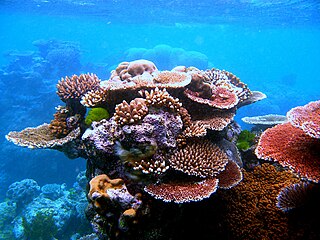
Anthozoa is a class of marine invertebrates which includes sessile cnidarians such as the sea anemones, stony corals, soft corals and sea pens. Adult anthozoans are almost all attached to the seabed, while their larvae can disperse as planktons. The basic unit of the adult is the polyp; this consists of a cylindrical column topped by a disc with a central mouth surrounded by tentacles. Sea anemones are mostly solitary, but the majority of corals are colonial, being formed by the budding of new polyps from an original, founding individual. Colonies are strengthened by calcium carbonate and other materials and take various massive, plate-like, bushy or leafy forms.

Medusozoa is a clade in the phylum Cnidaria, and is often considered a subphylum. It includes the classes Hydrozoa, Scyphozoa, Staurozoa and Cubozoa, and possibly the parasitic Polypodiozoa. Medusozoans are distinguished by having a medusa stage in their often complex life cycle, a medusa typically being an umbrella-shaped body with stinging tentacles around the edge. With the exception of some Hydrozoa, all are called jellyfish in their free-swimming medusa phase.

Zoanthids are an order of cnidarians commonly found in coral reefs, the deep sea and many other marine environments around the world. These animals come in a variety of different colonizing formations and in numerous different colors. They can be found as individual polyps, attached by a fleshy stolon or a mat that can be created from small pieces of sediment, sand and rock. The term "zoanthid" refers to all animals within this order Zoantharia, and should not be confused with "Zoanthus", which is one genus within Zoantharia.

Hexacorallia is a class of Anthozoa comprising approximately 4,300 species of aquatic organisms formed of polyps, generally with 6-fold symmetry. It includes all of the stony corals, most of which are colonial and reef-forming, as well as all sea anemones, and zoanthids, arranged within five extant orders. The hexacorallia are distinguished from another class of Anthozoa, Octocorallia, in having six or fewer axes of symmetry in their body structure; the tentacles are simple and unbranched and normally number more than eight. These organisms are formed of individual soft polyps which in some species live in colonies and can secrete a calcite skeleton. As with all Cnidarians, these organisms have a complex life cycle including a motile planktonic phase and a later characteristic sessile phase. Hexacorallia also include the significant extinct order of rugose corals.

Zoanthus sociatus, commonly known as the green sea mat or button polyp, is a zoanthid usually found in shallow reef zones of tropical regions from Caribbean to southeastern Brazil. Z. sociatus is currently being studied for its use against human lymphatic parasites.

Umimayanthus parasiticus, commonly known as the sponge zoanthid, is a species of coral in the order Zoantharia which grows symbiotically on several species of sponge. It is found in shallow waters in the Caribbean Sea and the Gulf of Mexico.

Hawaiian gold coral is a rare, extremely long-lived deep-sea coral found on seamounts near Hawaii. It is the only member of the monotypic genus Kulamanamana. Most colonies can live up to 2,470 years, based on a study using radiocarbon dating. In the Hawaiian Archipelago of the North Pacific Ocean, the Hawaiian gold coral is a crucial species to the ecology of Hawaiian seamounts. This is because it is a dominant macro-invertebrate found in the deep sea, and thus provides an important habitat for an array of invertebrates and fish. Gold coral tissue is reflective under light, and colonies are bioluminescent when mechanically stimulated, or touched. It is predicted that this bioluminescence perhaps attracts prey, however more research is needed to determine exactly what purpose it serves. Although it has been harvested commercially for use in jewelry for a long time, it was not formally described by taxonomists until 2012 when it was found to be related to both the genus Savalia and the octocoral-associated zoanthid, Corallizoanthus tsukaharai. Prior to being formally classified and named Kulamanamana haumeaae, the Hawaiian gold coral was previously known as Gerardia sp.

Zoanthus is a genus of anthozoans in the family Zoanthidae. It is the type genus for its family and order.

Palythoa is a genus of anthozoans in the order Zoantharia.

Isozoanthus sulcatus is a species of zoanthid in the family Parazoanthidae.
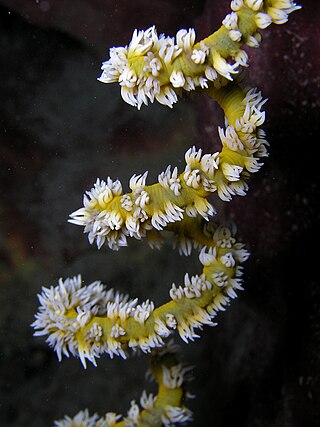
Cirrhipathes is a genus of black coral from the family Antipathidae. Coral species in this genus are commonly known as whip or wire corals because they often exhibit a twisted or coiled morphology. In addition to their colorful appearance, with colors ranging from yellow to red passing through blue and green, these species possess a dark skeleton that is characteristic to every black coral.

Zoanthus gigantus is a zoanthid first described from southern Japan.

Brachycnemina is a suborder of zoanthids in the order Zoantharia. Genetic analysis has been used to suggest Brachycnemina is a monophyletic group diverging within the paraphyletic Macrocnemina.
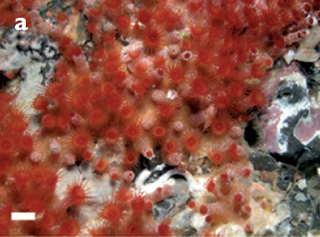
Terrazoanthus onoi is a species of uncertain validity of macrocnemic zoanthid first found in the Galapagos. It is potentially a junior synonym of Terrazoanthus patagonichus. It can be distinguished by its bright red oral disk colour, having about 32–40 tentacles, and having only basitrichs and mastigophores present in its pharynx.

Terrazoanthus sinnigeri is a species of uncertain validity of macrocnemic zoanthid first found in the Galapagos. It is potentially a junior synonym of Terrazoanthus patagonichus. It can be distinguished by commonly occurring on rubble and rocks on sandy bottoms, having about 30–36 tentacles, and numerous nematocysts in its pharynx.
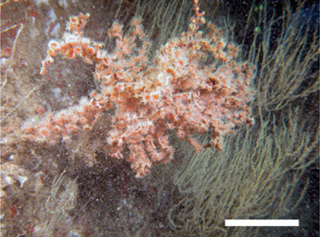
Antipathozoanthus hickmani is a species of macrocnemic zoanthid first found in the Galapagos. It can be distinguished by its exclusive association with Antipathes galapagensis, and having about 40 tentacles.

Parazoanthus darwini is a species of macrocnemic zoanthid first found in the Galapagos. It can be distinguished by its association with sponges, by having about 24–30 tentacles and polyps embedded in a well-developed coenenchyme.
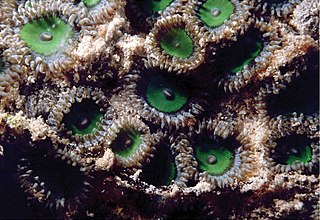
Zoanthus sansibaricus is a species of zoanthid generally found in the Indo-pacific but also off the western coast of South America. The range of habitation has been noted in intertidal zones along with areas below 7 m, but shows phenotypical and morphological differences based on depth and shading. Shaded individuals contain larger polyps compared to unshaded. It can be divided into three reproductive categories, male, female and asexual. Spawning has been observed within the middle of July, using lunar phases as an indicator. Various subclades are theorized to appear based on the time of year.

Antipathozoanthus is a genus of macrocnemic zoanthid in the family Parazoanthidae.



















